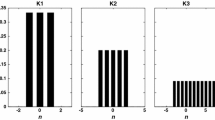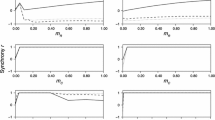Abstract
The aim of this paper is to understand how dispersal in a patchy environment influences the stability properties of tri-trophic metapopulations. Differential equation models for tri-trophic metapopulations are formulated and analysed. The patchy nature of the metapopulations is incorporated through dispersal phases. Two variants are studied: one with a dispersal phase for the top and one with a dispersal phase for the middle level. A complete characterisation of stable and unstable equilibria is given and the possibility of invasion in these food chains is studied. A dispersal phase for the middle level can destabilize the bottom level-middle level interaction, because of the delay that dispersal causes in the reaction to the resource. When the middle level is not efficiently controlled by the top level, the unstable bottom level-middle level pair can destabilize the entire food chain. Dispersal for the top level can destabilize in the same way. A characterisation of the long term behaviour of the models is given. Bistability with a stable three species equilibrium and a stable limit cycle is one of the possibilities.
Similar content being viewed by others
References
Alder, F.: Migration alone can produce persistence of host-parasitoid models. Am. Nat. 141, 642–650
Anderson, R. M. and May, R. M.: The population dynamics of microparasites and their invertebrate hosts. Phil. Trans. R. Soc. 291, 451–524 (1981)
Butler, G., Freedman, H. I. and Waltman, P.: Uniformly persistent systems. Proc. Am. Math. Soc. 96, 425–430 (1986)
Butler, G. and Waltman, P.: Bifurcation from a limit cycle in a two predator-one prey ecosystem modelled on a chemostat. J. Math. Biol. 12, 295–310 (1981)
Comins, H. N., Hassell, M. P. and May, R. M.: The spatial dynamics of host-parasitoid systems. J. Anim. Ecol. 61, 735–748 (1992)
Diekmann, O., Metz, J. A. J. and Sabelis, M. W.: Mathematical models of predator/prey/plant interactions in a patch environment. Exp. Appl. Acarol. 5, 319–342 (1988)
Farkas, M.: Stable oscillations in a predator-prey model with time lag. J. Math Anal. Appl. 102, 175–188 (1984)
Freedman, H. I. and Waltman, P.: Mathematical analysis of some three-species food-chain models. Math. Biosc. 33, 257–276 (1977)
Gard, T. C. and Hallam, T. G.: Persistence in food webs I: Lotka-Volterra food chains. Bull. Math. Biol. 41, 877–891 (1979)
Godfray, H. C. J. and Chan, M. S.: How insecticides trigger single-stage outbreaks in tropical pests. Func. Ecol. 4, 329–337 (1990)
Hadeler, K. P. and Freedman, H. L.: Predator-prey populations with parasitic infection. J. Math. Biol. 27, 609–631 (1989)
Hale, J. K. and Waltman, P.: Persistence in infinite-dimensional systems. SIAM J. Math. Anal. 20, 388–395 (1989)
Harrison, G. W.: Global stability of food chains. Am. Nat. 114, 455–457 (1978)
Hassell, M. P., Comins, H. and May, R. M.: Spatial structure and chaos in insect population dynamics. Nature 353, 252–258
Hastings, A.: Spatial heterogeneity and the stability of predator-prey systems, Theor. Pop. Biol. 12 (1977) 37–48
Hastings, A. and Powell, T. J.: Chaos in three species food chains. Ecology 72, 896–903 (1991)
Hofbauer, J.: A unified approach to persistence. Acta Appl. Math. 14, 11–22 (1989).
Hofbauer, J. and Sigmund, K.: The Theory of Evolution and Dynamical Systems. Cambridge University Press, Cambridge (1988)
Hogeweg, P. and Hesper, B.: Interactive instructions on population dynamics. Comp. Biol. Med. 8, 319–327 (1978)
Hutson, V.: A theorem on average Lyapunov functions. Monatsh. Math. 98, 267–275 (1984)
Hutson, V. and Vickers, T.: A criterion for permanent coexistence of species with an application to a two-prey one predator system. Math Biosci. 63, 253–269 (1983).
Jansen, V. A. A. and Sabelis, M. W.: Prey dispersal and predator persistence. Exp. Appl. Acarol. 14, 215–231 (1992)
Jansen, V. A. A. and Sabelis, M. W.: Outbreaks of colony-forming pests in tri-trophic systems: condequences for pest control and the evolution of pesticide resistance. Oikos (to appear)
Jansen, V. A. A.: The dynamics of two diffusively coupled, identical Lotka-Volterra patches. In: Jansen, V. A. A.: Theoretical Aspects of Metapopulation Dynamics. Ph.D. Thesis, Leiden University, Leiden (1994a)
Jansen, V. A. A.: On the bifurcation structure of two diffusively coupled predator-prey systems. In: Jansen, V. A. A.: Theoretical Aspects of Metapopulation Dynamics. Ph.D. Thesis, Leiden University, Leiden (1994b)
Khibnik, A. L., Kuznetsov, Y. A., Levitin, V. V. and Nikolaev E. V.: Continuation techniques and interactive software for bifurcation analysis of ODEs and iterated maps. Physica D 62, 360–371 (1993)
Klebanoff, A. and Hastings, A.: Chaos in three species food chains. J. Math. Biol. 32, 427–451 (1994)
Levins, R.: Some demographic and genetic consequences of environmental heterogeneity for biological control. Bull. Entomol. Soc. Am. 15, 237–240 (1969)
McCann, K. and Yodzis, P.: Bifurcation structure of a three species food chain model. Theor. Pop. Biol. 48 (1995)
Muratori, S. and Rinaldi, S.: Low- and high-frequency oscillations in three dimensional food chain systems. SIAM J. Appl. Math. 52, 1688–1706 (1992)
Nachman, G.: A acarine predator-prey metapopulation system inhabiting greenhouse cucumbers. Biol. J. Linn. Soc. 42, 285–303 (1991)
Sabelis, M. W. and Dicke, M.: Long-range dispersal and searching behaviour. In: Helle, W. and Sabelis, M. W. (eds.): Spider mites: their biology, natural enemies and control, Vol 1b. Amsterdam: Elsevier, pp. 141–160 (1985)
Sabelis M. W. and Diekmann, O.: Overall population stability despite local extinction: The stabilizing influence of prey dispersal from predator-invaded patches. Theor. Pop. Biol. 34, 169–176 (1988)
Sabelis M. W., Diekmann, O. and Jansen, V. A. A.: Metapopulation persistence despite local extinction: predator-prey patch models of the Lotka-Volterra type. Biol. J. Linn. Soc. 42, 267–283 (1991)
Sabelis, M. W. and Laane, W. E. M.: Regional dynamics of spider-mite populations that become extinct locally because of food source depletion and predation by phytoseiid mites (Acarina: Tetranychidae, Phytoseiidae). In: Metz, J. A. J. and Diekmann, O. (eds.): The dynamics of physiologically structured populations. (Lect. Notes Biomath. vol. 68) Berlin: Springer, pp. 345–375 (1986)
So, J. W. H.: A note on global stability and bifurcation phenomenon of a Lotka-Volterra food chain. J. Theor. Biol. 80, 185–187 (1979)
Author information
Authors and Affiliations
Rights and permissions
About this article
Cite this article
Jansen, V.A.A. Effects of dispersal in a tri-trophic metapopulation model. J. Math. Biol. 34, 195–224 (1995). https://doi.org/10.1007/BF00178773
Received:
Revised:
Issue Date:
DOI: https://doi.org/10.1007/BF00178773




